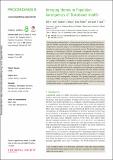Files in this item
Emerging themes in population consequences of disturbance models
Item metadata
| dc.contributor.author | Keen, Kelly A | |
| dc.contributor.author | Beltran, Roxanne S | |
| dc.contributor.author | Pirotta, Enrico | |
| dc.contributor.author | Costa, Daniel P | |
| dc.date.accessioned | 2021-09-10T11:30:12Z | |
| dc.date.available | 2021-09-10T11:30:12Z | |
| dc.date.issued | 2021-08-25 | |
| dc.identifier | 275694999 | |
| dc.identifier | ff6ea495-7cfd-4dfc-a137-3e97f9129ae9 | |
| dc.identifier | 34428966 | |
| dc.identifier | 85114967801 | |
| dc.identifier | 000691050300006 | |
| dc.identifier.citation | Keen , K A , Beltran , R S , Pirotta , E & Costa , D P 2021 , ' Emerging themes in population consequences of disturbance models ' , Proceedings of the Royal Society B: Biological Sciences , vol. 288 , no. 1957 , 20210325 . https://doi.org/10.1098/rspb.2021.0325 | en |
| dc.identifier.issn | 0962-8452 | |
| dc.identifier.other | ORCID: /0000-0003-3541-3676/work/106838541 | |
| dc.identifier.uri | https://hdl.handle.net/10023/23938 | |
| dc.description | Funding: K.A.K., R.S.B. and D.P.C. were supported by the E&P Sound and Marine Life Joint Industry Programme (JIP) of the International Association of Oil and Gas Producers (IOGP) (grant no. 00-07-23). K.A.K. was also supported by the National Defense Science and Engineering Graduate (NDSEG) Fellowship. E.P. was supported by the Office of Naval Research (ONR) (grant no. N00014-19-1-2464). D.P.C. was also supported by ONR (grant no. N00014-18-1-2822). | en |
| dc.description.abstract | Assessing the non-lethal effects of disturbance from human activities is necessary for wildlife conservation and management. However, linking short-term responses to long-term impacts on individuals and populations is a significant hurdle for evaluating the risks of a proposed activity. The Population Consequences of Disturbance (PCoD) framework conceptually describes how disturbance can lead to changes in population dynamics, and its real-world application has led to a suite of quantitative models that can inform risk assessments. Here, we review PCoD models that forecast the possible consequences of a range of disturbance scenarios for marine mammals. In so doing, we identify common themes and highlight general principles to consider when assessing risk. We find that, when considered holistically, these models provide valuable insights into which contextual factors influence a population's degree of exposure and sensitivity to disturbance. We also discuss model assumptions and limitations, identify data gaps and suggest future research directions to enable PCoD models to better inform risk assessments and conservation and management decisions. The general principles explored can help wildlife managers and practitioners identify and prioritize the populations most vulnerable to disturbance and guide industry in planning activities that avoid or mitigate population-level effects. | |
| dc.format.extent | 13 | |
| dc.format.extent | 903873 | |
| dc.language.iso | eng | |
| dc.relation.ispartof | Proceedings of the Royal Society B: Biological Sciences | en |
| dc.subject | Bioenergetics | en |
| dc.subject | Anthropogenic disturbance | en |
| dc.subject | Life-history traits | en |
| dc.subject | Population dynamics | en |
| dc.subject | Risk assessment | en |
| dc.subject | Marine mammals | en |
| dc.subject | QH301 Biology | en |
| dc.subject | T-DAS | en |
| dc.subject | SDG 14 - Life Below Water | en |
| dc.subject.lcc | QH301 | en |
| dc.title | Emerging themes in population consequences of disturbance models | en |
| dc.type | Journal article | en |
| dc.contributor.institution | University of St Andrews. School of Biology | en |
| dc.contributor.institution | University of St Andrews. Centre for Research into Ecological & Environmental Modelling | en |
| dc.identifier.doi | 10.1098/rspb.2021.0325 | |
| dc.description.status | Peer reviewed | en |
This item appears in the following Collection(s)
Items in the St Andrews Research Repository are protected by copyright, with all rights reserved, unless otherwise indicated.

